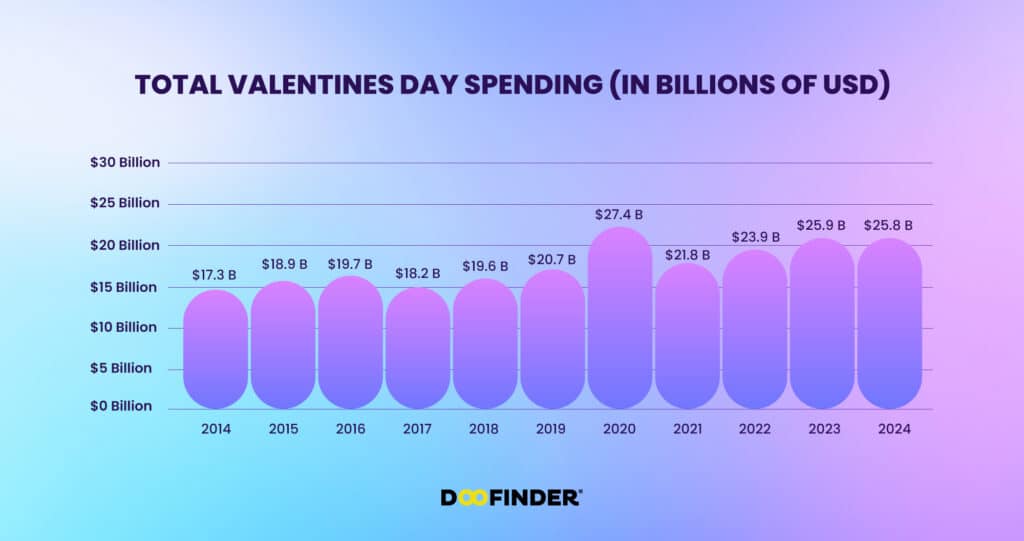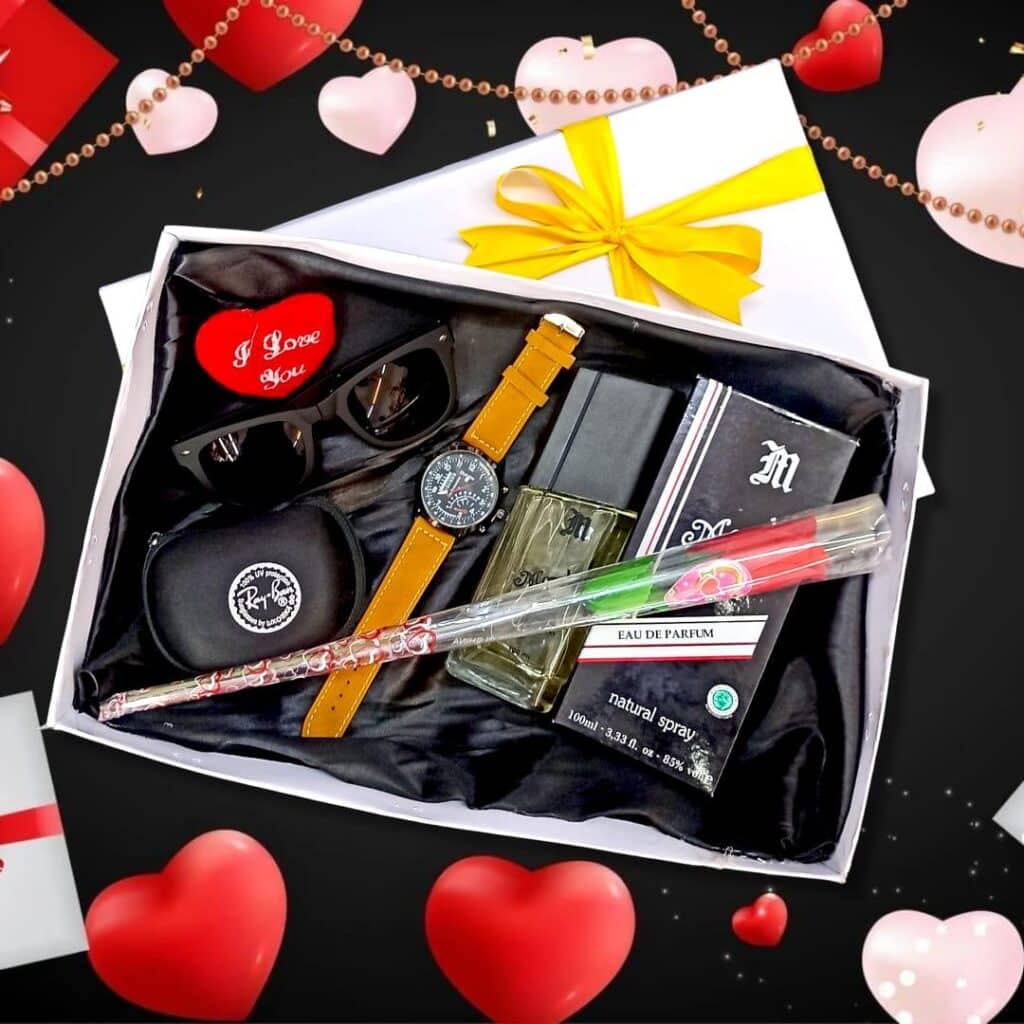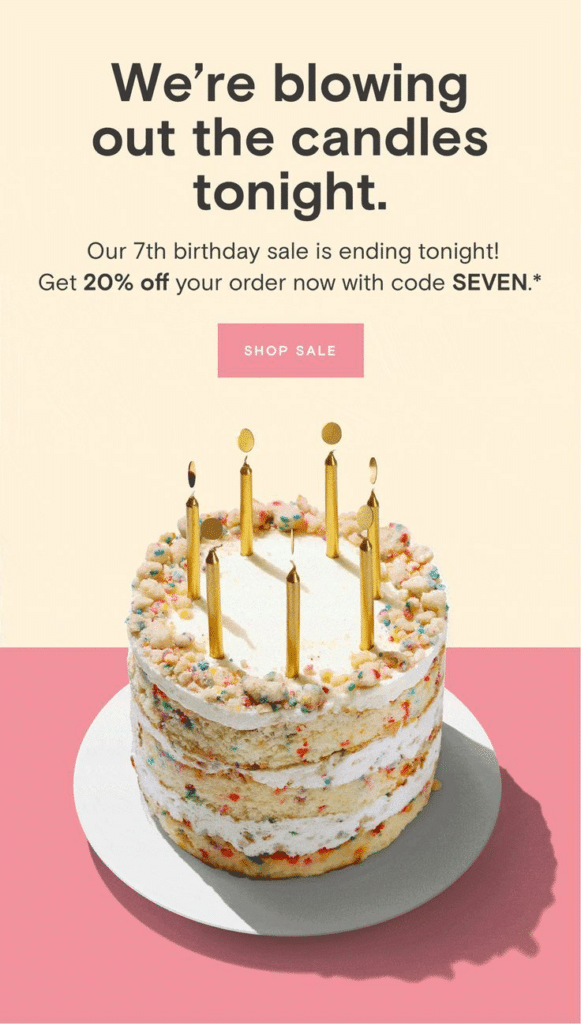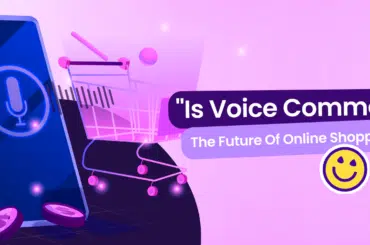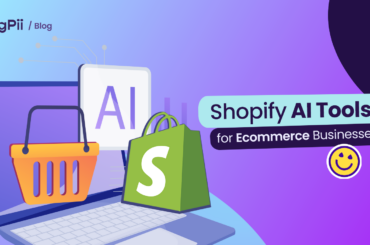Valentine’s Day isn’t just about roses and chocolates anymore—it’s a booming retail opportunity that eCommerce businesses can’t ignore.
In 2025, U.S. consumers are expected to spend a record $27.5 billion on Valentine’s Day, with online shopping accounting for a significant portion of sales.
But here’s the catch: while many businesses focus on capturing seasonal sales, few take the steps to turn these one-time shoppers into loyal, repeat customers.
What’s more, Valentine’s Day gifting has expanded far beyond romantic partners. Today, 32% of consumers buy gifts for their pets, while 19% shop for friends, coworkers, and themselves. This shift opens up a world of opportunities for eCommerce brands to connect with a broader audience and build lasting relationships.
This article explores 15 actionable strategies for retaining Valentine’s Day shoppers and turning them into lifetime customers.
From personalized shopping experiences to post-holiday engagement, these tips will ensure your business stands out long after the flowers have wilted and the chocolates are gone.
Why Retaining Valentine’s Day Shoppers Matters
Valentine’s Day is one of the most lucrative shopping seasons, but its true potential lies in what happens after the holiday. While many businesses focus on driving sales during the season, the real win is turning those one-time shoppers into loyal, repeat customers. Here’s why:
-
Customer Retention is More Cost-Effective Than Acquisition:
Acquiring a new customer can cost 5x more than retaining an existing one. By focusing on customer retention, you can maximize the lifetime value of the customers you’ve already won during Valentine’s Day.
-
Seasonal Shoppers Are Already Engaged:
Valentine’s Day shoppers are actively looking to spend, making them prime candidates for repeat purchases. In fact, 40% of consumers purchase greeting cards during the season, and many of these shoppers are open to buying more if the experience is memorable.
-
The Trend of Extended Gifting Creates Opportunities:
With more people buying gifts for pets, friends, and coworkers, there’s a growing opportunity to cater to diverse customer segments. For example, 27% of consumers now purchase Valentine’s Day gifts for their pets, showcasing the potential to tap into niche markets.
-
Repeat Customers Spend More
Loyal customers are easier to sell to and spend 67% more than new customers. Retaining Valentine’s Day shoppers sets the stage for higher revenue in the long run.
In short, Valentine’s Day isn’t just a sales opportunity—it’s a gateway to building lasting customer relationships. Implementing the right strategies can turn seasonal shoppers into your most valuable asset.
15 Actionable Steps to Turn Valentine’s Day Shoppers into Lifetime Customers
-
Personalize the Shopping Experience
Personalization is key to making customers feel valued and understood. Use the data you collect during Valentine’s Day purchases—such as browsing history, past purchases, and customer preferences—to tailor their shopping experience.
For example, if a customer buys a Valentine’s Day gift for their pet, suggest related products, such as pet accessories, toys, or treats, for future occasions.
You can also personalize email campaigns by addressing customers by name and recommending products based on their interests.
Why It Works: According to Epsilon, 80% of consumers are more likely to purchase when brands offer personalized experiences.
Actionable Tip: Invest in tools like AI-driven recommendation engines or email marketing platforms that allow for dynamic content based on customer behavior.
-
Send a Thank-You Email After Purchase
A simple thank-you email can go a long way in building customer loyalty. After a Valentine’s Day purchase, send a heartfelt email expressing gratitude for their business.
This is also an excellent opportunity to include a discount code or special offer to encourage their next purchase.
For example, you could say, “Thank you for celebrating love with us! As a token of our appreciation, here’s 10% off your next order.”
Why It Works: A thank-you email shows appreciation and keeps your brand top-of-mind.
Actionable Tip: Use email automation tools to send thank-you emails immediately after purchase, and include a clear call-to-action like “Shop Now” or “Redeem Your Discount.”
-
Create a Post-Valentine’s Day Follow-Up Campaign
Don’t let the relationship end after Valentine’s Day. Create a follow-up campaign to stay connected with your customers.
You can promote “Galentine’s Day” bundles for friends or self-care products for post-holiday relaxation.
To keep your brand relevant year-round, you can send emails highlighting upcoming holidays or events, such as Mother’s Day or anniversaries.
Why It Works: Email marketing has an average ROI of $36% for every $1 spent, making it one of the most cost-effective ways to retain customers.
Actionable Tip: Segment your email list based on purchase behavior (e.g., pet owners, gift-givers) and tailor your follow-up campaigns to each group.
-
Leverage Social Media Engagement
Social media is a powerful tool for building relationships with your customers. Encourage them to share their Valentine’s Day purchases on Instagram, Facebook, or TikTok.
Run contests or giveaways to boost engagement and create a sense of community around your brand. For example, you could say, “Share a photo of your Valentine’s Day gift and tag us for a chance to win a $50 gift card!”
Why It Works: User-generated content builds trust and authenticity, as customers are more likely to trust recommendations from their peers.
Actionable Tip: Use branded hashtags to track UGC and feature customer posts on your social media channels to show appreciation and encourage more participation.
-
Offer a Loyalty Program
Loyalty programs are a proven way to incentivize repeat purchases. Reward customers with points, discounts, or exclusive perks for continued support.
For example, you could offer a loyalty program where customers earn 1 point for every $1 spent, and once they reach 100 points, they receive $10 off their next purchase.
You can also create tiered loyalty programs to reward your most loyal customers with VIP benefits like early access to sales or free shipping.
Why It Works: According to Bond Brand Loyalty, 75% of consumers are more likely to shop with brands that offer loyalty programs.
Actionable Tip: Use loyalty program software to track customer points and send personalized rewards based on their purchase history.
-
Provide Exceptional Customer Service
Outstanding customer service can set your brand apart and turn one-time shoppers into loyal advocates. Ensure your team is trained to handle inquiries quickly and resolve issues effectively.
To make it easy for customers to contact you, offer multiple support channels, such as live chat, email, and phone.
For example, if a customer has a problem with their Valentine’s Day order, go above and beyond to make it right—whether that means offering a replacement, a refund, or a discount on their next purchase.
Why It Works: 90% of Americans use customer service to decide whether to do business with a company.
Actionable Tip: Use chatbots for instant responses to common questions and ensure your support team is available during peak hours.
-
Use Retargeting Ads
Not all Valentine’s Day shoppers will purchase their first visit. Use retargeting ads to remind them of the products they viewed but didn’t buy.
Platforms like Facebook, Instagram, and Google Ads allow you to create dynamic ads showcasing the items they were interested in.
For example, if a customer added a pair of earrings to their cart but didn’t check out, you can show them an ad featuring those earrings with a message like, “Still thinking about it? These earrings are waiting for you!”
Why It Works: Retargeting ads can increase conversion rates by 150%.
Actionable Tip: Set up retargeting campaigns with compelling visuals and clear CTAs, and offer a small discount to encourage purchases.
-
Bundle Products for Future Occasions
Create product bundles that cater to future occasions, such as anniversaries, birthdays, or even “just because” moments.
For example, if a customer bought a Valentine’s Day gift for their partner, offer them a curated anniversary bundle, such as a wine and cheese set or a spa gift box.
This simplifies their shopping experience and encourages them to return to your store for future needs.
Why It Works: Bundles increase the average order value and make it easier for customers to find the perfect gift.
Actionable Tip: Use data from Valentine’s Day purchases to create bundles that align with your customer’s preferences.
-
Ask for Feedback
After the Valentine’s Day rush, send your customers a survey asking for feedback on their shopping experience.
This could include questions about product quality, delivery times, and overall satisfaction. Use this feedback to identify areas for improvement and show customers that their opinions matter.
For example, you could say, “We’d love to hear about your experience! Take our 2-minute survey and get 10% off your next order.”
Why It Works: Feedback helps improve your business while making customers feel heard and valued.
Actionable Tip: Use tools like FigPii Polls, SurveyMonkey or Typeform to create short, engaging surveys and incentivize participation.
-
Create a Subscription Model
Turn one-time buyers into repeat customers by offering a subscription model for regularly used products.
If you sell chocolates, flowers, or self-care items, create a subscription service that delivers these products monthly or quarterly. This not only ensures recurring revenue but also keeps your brand top-of-mind.
Why It Works: Subscription models build long-term customer relationships and provide predictable revenue streams.
Actionable Tip: Promote your subscription service during checkout or through email campaigns, highlighting its convenience and savings.
-
Highlight Your Brand’s Story and Values
Customers are more likely to stay loyal to brands they feel connected to. Share your brand’s story, mission, and values through your website, social media, and email campaigns.
If your brand supports a cause like sustainability or animal welfare, highlight how each purchase contributes to that mission. This emotional connection can turn one-time shoppers into lifelong advocates.
Why It Works: 64% of consumers say shared values are the primary reason they have a relationship with a brand.
Actionable Tip: To humanize your brand, create an “Our Story” page on your website and share behind-the-scenes content on social media.
-
Send Personalized Discounts on Special Occasions
Use customer data to send personalized discounts on special occasions like birthdays, anniversaries, or holidays.
Let’s say a customer’s birthday is approaching. Send them an email with a subject line like, “Celebrate Your Special Day with 20% Off!” This not only encourages a purchase but also makes the customer feel valued.
Why It Works: Personalized offers make customers feel appreciated and increase the likelihood of repeat purchases.
Actionable Tip: Use your CRM or email marketing platform to track customer milestones and automate personalized discount emails.
-
Host Exclusive Events or Sales for Returning Customers
Offer returning customers exclusive access to sales, events, or new product launches to make them feel special.
For example, you could host a “VIP Valentine’s Day Preview Sale” where loyal customers can access your Valentine’s Day collection early. This would create a sense of exclusivity and reward their loyalty.
Why It Works: Exclusive offers make customers feel like insiders, increasing their emotional connection to your brand.
Actionable Tip: Use email campaigns and loyalty program notifications to promote these exclusive events.
-
Encourage Referrals
Turn your satisfied customers into brand advocates by encouraging them to refer friends and family. Offer incentives like discounts, store credit, or free products for successful referrals.
You could say, “Refer a friend and get $10 off your next order when they make a purchase!”
Why It Works: Referral marketing is highly effective because people trust recommendations from friends and family. According to research by the NNN group, 92% of consumers trust referrals from people they know.
Actionable Tip: Use referral marketing software to track referrals and automate rewards.
-
Stay in Touch Year-Round
Don’t let the relationship fade after Valentine’s Day. Stay in touch with your customers year-round through email newsletters, social media updates, and seasonal promotions. Share helpful content, product updates, and exclusive offers to engage them.
For example, you could send a summer-themed email with the subject line “Beat the Heat with Our Summer Essentials!”
Why It Works: Consistent communication keeps your brand top-of-mind and builds long-term relationships.
Actionable Tip: Create a content calendar to plan seasonal campaigns and ensure regular communication with your audience.
Final Thoughts
Valentine’s Day is more than just a seasonal sales spike, it’s a golden opportunity to connect with customers meaningfully.
With U.S. consumers spending billions on gifts for partners, pets, friends, and coworkers, the potential to turn these shoppers into loyal, repeat customers has never been greater.
But the real magic happens when you go beyond the sale and focus on building relationships that last long after the holiday.
The strategies we’ve explored aren’t just about retention, they’re about creating a community of customers who love what you do and keep coming back for more.
So, as you prepare for this Valentine’s Day, remember that the flowers may fade and the chocolates may disappear, but the relationships you build with your customers can last a lifetime.


